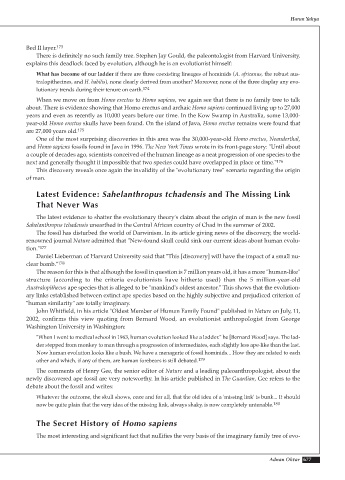Page 679 - Atlas of Creation Volume 2
P. 679
Harun Yahya
Bed II layer. 173
There is definitely no such family tree. Stephen Jay Gould, the paleontologist from Harvard University,
explains this deadlock faced by evolution, although he is an evolutionist himself:
What has become of our ladder if there are three coexisting lineages of hominids (A. africanus, the robust aus-
tralopithecines, and H. habilis), none clearly derived from another? Moreover, none of the three display any evo-
lutionary trends during their tenure on earth. 174
When we move on from Homo erectus to Homo sapiens, we again see that there is no family tree to talk
about. There is evidence showing that Homo erectus and archaic Homo sapiens continued living up to 27,000
years and even as recently as 10,000 years before our time. In the Kow Swamp in Australia, some 13,000-
year-old Homo erectus skulls have been found. On the island of Java, Homo erectus remains were found that
are 27,000 years old. 175
One of the most surprising discoveries in this area was the 30,000-year-old Homo erectus, Neanderthal,
and Homo sapiens fossils found in Java in 1996. The New York Times wrote in its front-page story: "Until about
a couple of decades ago, scientists conceived of the human lineage as a neat progression of one species to the
next and generally thought it impossible that two species could have overlapped in place or time." 176
This discovery reveals once again the invalidity of the "evolutionary tree" scenario regarding the origin
of man.
Latest Evidence: Sahelanthropus tchadensis and The Missing Link
That Never Was
The latest evidence to shatter the evolutionary theory's claim about the origin of man is the new fossil
Sahelanthropus tchadensis unearthed in the Central African country of Chad in the summer of 2002.
The fossil has disturbed the world of Darwinism. In its article giving news of the discovery, the world-
renowned journal Nature admitted that "New-found skull could sink our current ideas about human evolu-
tion." 177
Daniel Lieberman of Harvard University said that "This [discovery] will have the impact of a small nu-
clear bomb." 178
The reason for this is that although the fossil in question is 7 million years old, it has a more "human-like"
structure (according to the criteria evolutionists have hitherto used) than the 5 million-year-old
Australopithecus ape species that is alleged to be "mankind's oldest ancestor." This shows that the evolution-
ary links established between extinct ape species based on the highly subjective and prejudiced criterion of
"human similarity" are totally imaginary.
John Whitfield, in his article "Oldest Member of Human Family Found" published in Nature on July, 11,
2002, confirms this view quoting from Bernard Wood, an evolutionist anthropologist from George
Washington University in Washington:
"When I went to medical school in 1963, human evolution looked like a ladder." he [Bernard Wood] says. The lad-
der stepped from monkey to man through a progression of intermediates, each slightly less ape-like than the last.
Now human evolution looks like a bush. We have a menagerie of fossil hominids... How they are related to each
other and which, if any of them, are human forebears is still debated. 179
The comments of Henry Gee, the senior editor of Nature and a leading paleoanthropologist, about the
newly discovered ape fossil are very noteworthy. In his article published in The Guardian, Gee refers to the
debate about the fossil and writes:
Whatever the outcome, the skull shows, once and for all, that the old idea of a 'missing link' is bunk... It should
now be quite plain that the very idea of the missing link, always shaky, is now completely untenable. 180
The Secret History of Homo sapiens
The most interesting and significant fact that nullifies the very basis of the imaginary family tree of evo-
Adnan Oktar 677

